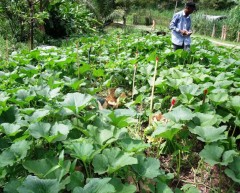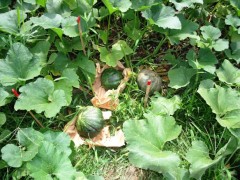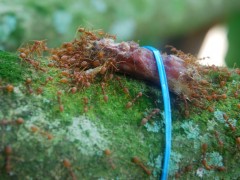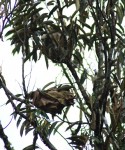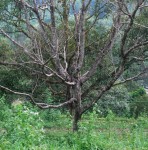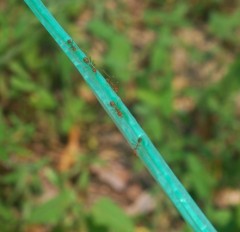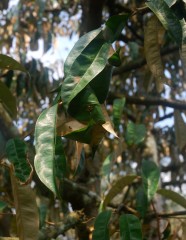Jun 28, 2009
Sustainable Farming
Sustainable farming in practice here:
1. This is a 'No-Dig' 35 feet x 10 feet pumpkin patch. Barely 2 months, we now have 42 pumpkins (the red tips mark the pumpkins), with more to come judging by the flowers.
2. The original soil is sandy. We build up the beds using compost, some soil and mulch.
3. Three varieties of pumpkins are planted here, creating diversity to reduce outbreaks of insect or fungal and bacterial problems. So far we have had one bacterial problem which we quickly addressed by uprooting and destroying the plant. Fungal problems have been minimal and have been addressed by quick action using cassia alata juice. Insects have not been serious. The beetle A. abdominalis is present but does not seem to cause any problems to the pumpkin plants.
4. No purchased fertiliser, or any other input have been used here. We only use our farm made compost.
5. We are now looking forward to see whether a second crop of pumpkins using the same plot of land can produce similar yields. That would really be a test of sustainability.

17:45 Posted in Sustainable Farming | Permalink | Comments (2) | Tags: sustainable farming, pumpkins
Jun 08, 2009
Kerengga - Our Organic Partners
Sceptics say, organic durians, sure? How do you handle weevils that just love durians and can easily infest 40% of your fruits? Or what about borers that kill the trees in weeks after you have lovingly taken care of the trees for years? And squirrels, they love the durians, so what do you do, kill them?
Well, we have a few hundred durian and mango trees and we will tell you it's almost impossible (the labour costs will be too high) if not for our "friendly" neighbourhood kerengga ( weaver ants, or oecophylla smaragdina )
Gang of carnivorous kerengga attacking a piece of meat. Meat is used to establish a colony in a new tree.
Kerengga nests the size of large durians.
A tree killed by borers.
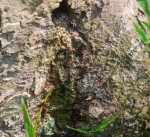
A borer hole that's dry after kerengga cleaned out the borers
Highway of raffia strings for the weaver ants to form a colony of 20 to 30 trees around one central tree.
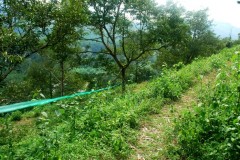
Using the highway
New weaver ant nests as they colonise a new tree.
Once the weaver ants colonise a tree, the borers are gone. Weevil infested fruits and squirrel attacks are almost non-existent. That gives us time to focus on the other major problem with durian trees – phytoptera attacks, for which sadly, we have no answer as yet.
19:59 Posted in Sustainable Farming | Permalink | Comments (2) | Tags: weaver ants, natural enemies








